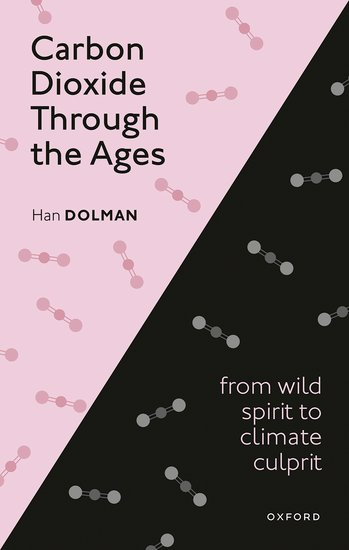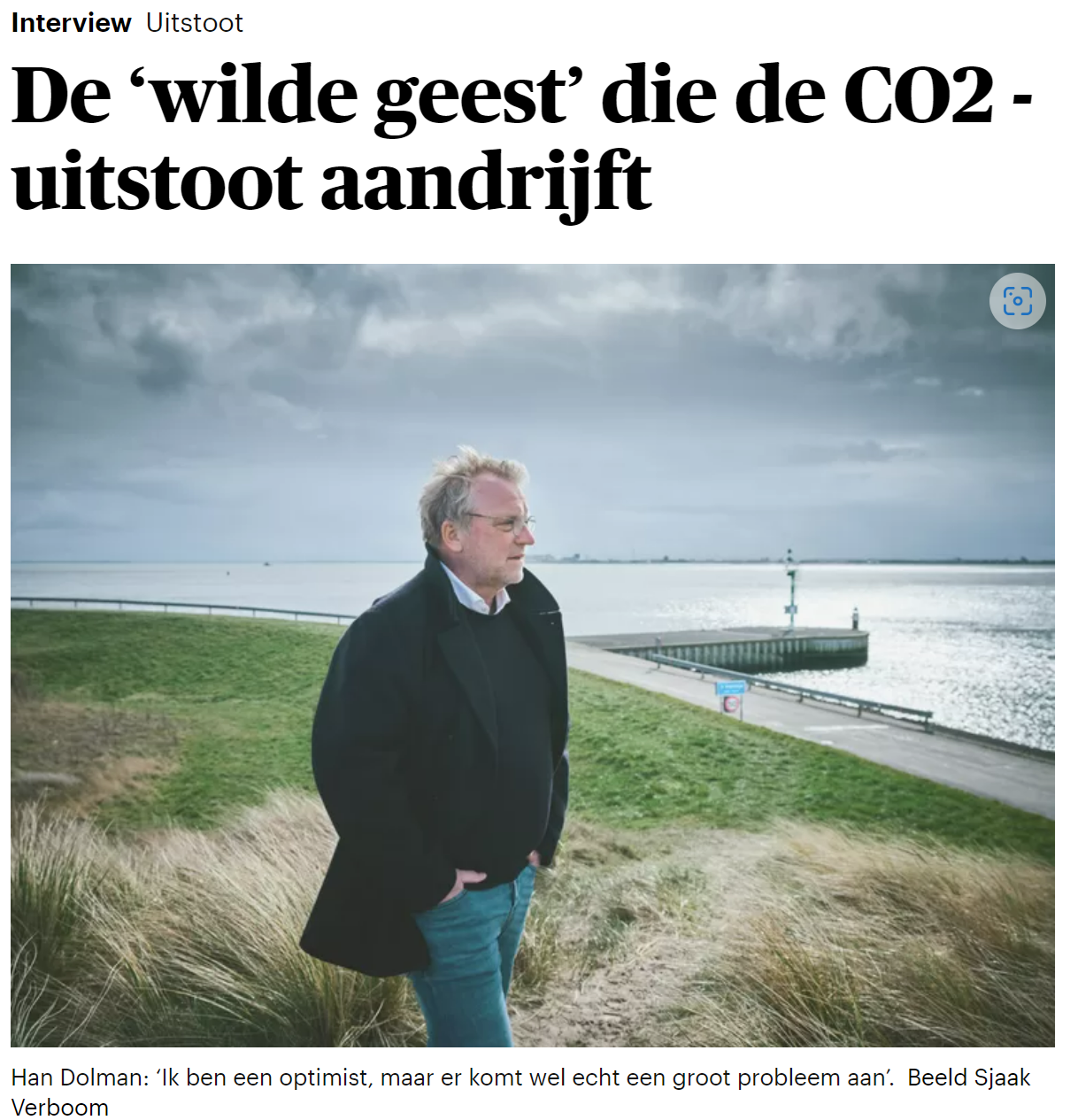NIOZ director Han Dolman's book 'Carbon dioxide through the ages: from wild spirit to climate culprit'
Everything you always wanted to know about carbon dioxide
When Flemish physician Jean Baptista van Helmont burnt a neatly measured amount of coal in the year 1600, he was left with only a tiny bit of ash. The rest blew into the air like, what he called, a spiritus silvestris, or ‘wild spirit’. Although at that time he was not yet able to capture and precisely analyze the gas, van Helmont is considered to be the first to identify carbon dioxide. This history marks the beginning of NIOZ director Han Dolman's new book, Carbon dioxide through the ages, From wild spirit to climate culprit (Oxford University Press).
Historical greenhouse
Not only the discovery of carbon dioxide goes way back. The notion that this gas can retain solar heat and thus keep the earth pleasantly warm and livable, also dates back to the nineteenth century. In 1856, American scientist and women's rights activist Eunice Foote was the first to see how CO2 in her laboratory retained solar heat from infrared radiation. In 1896, the Swede Svante Arrhenius also linked the regular occurrence of ice ages in history to the content of CO2 in the atmosphere. The ‘greenhouse effect’ must thus be considered as known for more than a century. Not much later, the link between the burning of fossil fuels and the accumulation of CO2 in the atmosphere was also discovered, Dolman writes in his book.
Late sense of urgency
Yet, it took another century or so before any sense of urgency was added. Dolman marks the UN climate conference in Paris, in 2015 as a tipping point. It was not until that conference that enough policymakers saw the urgency of doing something about the exceedingly large emissions of carbon dioxide, which are wrapping around us like a blanket, too warm.
That sense of urgency has hardly translated yet into actual action. The direct link between the CO2 content of the atmosphere and the earth's average temperature still allows emissions of about one hundred gigatons of CO2 if we want to limit the rise in temperature to one and a half degree. At the rate at which we are burning today, that point will be reached within ten years.
CO2 cycles
In his book, Dolman describes not only the history of CO2 and greenhouse science, but also the carbon cycles in both the dead and living nature; from the emission of the greenhouse gas from volcanoes to the weathering of rocks, which reabsorbs CO2, and the storage of the greenhouse gas in trees and other biomass. The leading role of the oceans in absorbing carbon dioxide is also discussed in detail. In doing so, the book also provides the ingredients for much-needed action. Limiting the enhanced greenhouse effect is no longer possible without actively removing CO2 from the atmosphere. Dolman foresees an important role for ocean science there.
NIOZ-directeur Han Dolman's boek 'Carbon dioxide through the ages: from wild spirit to climate culprit'
Alles wat je altijd al wilde weten over CO2
Toen de Vlaamse arts Jean Baptista van Helmont in 1600 een keurig afgepaste hoeveelheid steenkool verbrandde, hield hij maar een heel klein beetje as over. De rest vloog de lucht in als, zoals hij dat noemde, een spiritus silvestris, een ‘wilde geest’. Hoewel hij in die dagen nog niet in staat was om al dat gas op te vangen en precies te analyseren, wordt van Helmont wel gezien als de eerste die koolstofdioxide identificeerde.
Deze geschiedenis markeert het begin van het nieuwe, Engelstalige boek van NIOZ-directeur Han Dolman, Carbon dioxide through the ages, From wild spirit to climate culprit (Oxford University Press). Daarin volgt Dolman nauwgezet de geschiedenis van het belangrijkste broeikasgas, van de ontdekking in 1600, tot de problemen die de wereldgemeenschap nu met deze ‘wilde geest’ heeft.
Historische broeikas
Niet alleen de ontdekking van koolstofdioxide gaat al ver terug. Ook de notie dat dit gas zonnewarmte kan vasthouden en daarmee de aarde aangenaam warm en leefbaar houdt, dateert al uit de negentiende eeuw. In 1856 was de Amerikaanse wetenschapper en vrouwenrechtenactivist Eunice Foote de eerste die zag hoe CO2 in haar laboratorium zonnewarmte uit infrarode straling vasthield. De Zweed Svante Arrhenius legde in 1896 ook de link tussen het regelmatig optreden van ijstijden in de geschiedenis en het gehalte van CO2 in de atmosfeer. Het ‘broeikaseffect’ moet daarmee dus al meer dan een eeuw als bekend worden verondersteld. Niet veel later werd ook de link tussen het verbranden van fossiele brandstoffen en het ophopen van CO2 in de atmosfeer ontdekt, zo schrijft Dolman in zijn boek.
Laat gevoel van urgentie
Toch duurde het nog een kleine eeuw voordat daar ook enig gevoel van urgentie bij kwam. Dolman markeert de VN-klimaatconferentie in Parijs, in 2015 als een kantelpunt. Pas vanaf dat moment zagen voldoende beleidsmakers de urgentie om iets te doen aan de veel te grote uitstoot van koostofdioxide, die als een te warme deken om ons heen komt te liggen.
Dat gevoel van urgentie heeft zich nog nauwelijks vertaald in daadwerkelijk handelen. De harde koppeling van het CO2-gehalte in de atmosfeer en de gemiddelde temperatuur op aarde laat nog een uitstoot toe van ongeveer honderd gigaton CO2, willen we de stijging van de temperatuur tot anderhalve graad beperken. In het tempo waarin we nu nog doorstoken, is dat punt binnen tien jaar bereikt.
CO2-kringlopen
Dolman beschrijft in zijn boek niet alleen de geschiedenis van CO2 en de broeikaswetenschap, maar ook de koolstofkringlopen in de ‘dode’ en de levende natuur; van de uitstoot van het broeikasgas uit vulkanen tot het verweren van rotsen, waarbij CO2 weer wordt opgenomen, en de opslag van het broeikasgas in bomen en andere biomassa. Ook de hoofdrol van de oceanen in het opnemen van koolstofdioxide komt uitgebreid aan bod. Daarmee biedt het boek ook de ingrediënten voor de broodnodige actie. Het beperken van het versterkte broeikaseffect kan niet meer zonder het actief verwijderen van CO2 uit de atmosfeer. Dolman voorziet daar een belangrijke rol voor de oceaanwetenschap.

